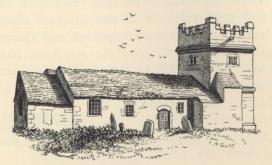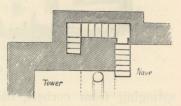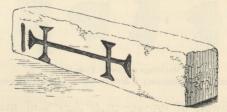The following description is lifted directly from [Blight 1885] but note that the text was prepared for the Gentleman’s Magazine 1862-64 and is largely unaltered. It must be read in the context of that date. The drawings are by the author.
TOWEDNACK CHURCH is remarkable as alone possessing a chancel-arch among the churches of West Cornwall; it is of the thirteenth century, very acutely pointed, and consists simply of two chamfered orders springing from corbels, like the transept-arch at St. Gwithian h, which is of the same date.

Towednack Church.
The church consists of chancel, nave with western tower, and south aisle and porch; the two latter are much later than the other parts.

Mouldings of Tower,
Towednack.
1. Cornice; 2. Battlement; 3. Stringcourse; 4. Impost,
Tower-arch
The tower, of granite, very low and massive, is altogether unlike every other in the district, and, being constructed without any attempt at ornamentation, proper use was made of the material at hand. The stringcourse and cornice are remarkably bold; the battlemented parapet (walled in on the east and west sides) is of the simplest character. The belfry lights are square-headed and chamfered.

Plan of Tower Stairs, Towednack.
Altogether it is a characteristic structure, harmonizing well with its site, in the midst of a most wild and dreary region. The tower staircase, on an unusual plan, is constructed without newel or winders, and has its entrance direct from the north-west angle of the nave. The tower-arch appears to have been originally, like most others of the same date in Cornwall, a plain soffit-arch; to this responds and a chamfered order have been added. A portion of the old impost-moulding remains.

Incised Stone, Towednack.
The eastern bench in the porch is formed of a block of granite, 7 ft. long, x ft. 6 in. high, and 10 in. wide, with an incised double cross. This stone evidently does not occupy its original position; it differs from the ordinary types of the Cornish church-yard and wayside crosses, and is most probably an early Christian sepulchral monument.
(h) See the book from which these extracts are taken, p. 136.
[The book continues with Zennor.]